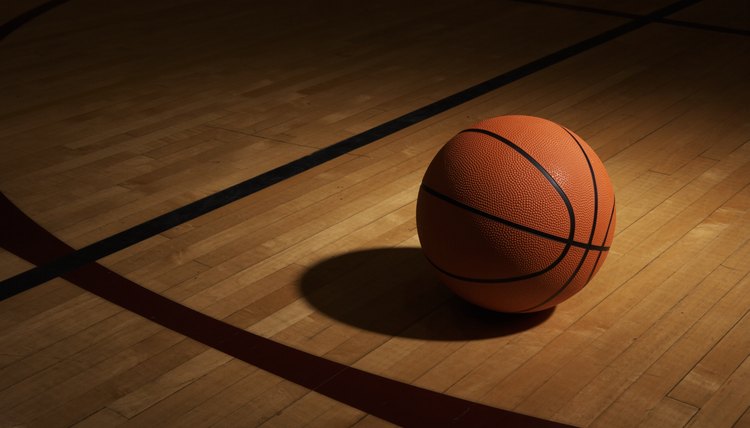The Physics of Basketball Player Hang Times

One of the most impressive parts of basketball is watching a player’s hang time. Not only do you want to see who can hang in the air the longest, but you also want to know how to get that long hang time. When you understand the science behind hang times, you can figure out how to increase your own.
Jumping
To understand hang time, you have to understand the importance of jumping. When you jump to take a shot, you can appear suspended in mid air at the high point of the jump. This illusion is a result of projectile motion. Projectile motion simply states that, when thrown into the air, an object, or in this case you, will spend the majority of the time at the top of the throw.
The higher you jump, the greater your hang time. Most players can jump a maximum of about 4 feet. Because gravity is a constant force and your vertical leap is not, your vertical leap, combined with the force of gravity, will change if you work at it. You can increase the strength of your vertical leap by going through exercises with your coach or trainer that build strength and speed in your legs. These exercises include jumping straight in the air, jumping onto boxes or steps of various heights, speed work like sprinting, and strength training for your legs.
Velocity of the Jump
There is more to your jump than simply the distance you travel vertically. You also have to take into account your takeoff. The takeoff is when you are running forward with the ball and then leap into the air. Because this is all happening so fast and you still are traveling forward through the air, the horizontal and vertical components happen at the same time, even though they represent two components of hang time. The horizontal component, or the distance you travel forward, does not change over time because it is not affected by gravity.
If you look at total hang time as an arc, or the top half of a circle, you spend half of your time in the top part of the arc, with the other half split between your takeoff and landing. As you increase the velocity and strength of your takeoff, you will be able to increase your hang time. Remember that your horizontal and vertical components happen at the same time; that is why it is represented by an arc. The shape of the arc changes as your takeoff changes. The more power you have in your takeoff, which represents both your vertical leap and the distance you travel horizontally, the high the arc will be and the longer you will appear to be in the air.
The Science and Math of Hang Time
In order to calculate your hang time for basketball, use a combination of the laws of physics and mathematical equations. Newton's First Law essentially states that an object in motion will remain at motion unless acted upon by an outside force. This concerns you flying through the air. Newton's Second Law explains how an outside force changes the velocity of an object. Newton was able to put the second law in mathematical terms when the object, in this case you, has a constant mass. This equation is F = m x a, where “F” stands for force, “m” is mass and “a” is acceleration.
When you apply both laws to your hang time, it means that you will come down to the floor at the same rate you rose from the floor, assuming you don’t come into contact with anything. The outside force causing you to come back down to the floor is gravity, which is constant. The resulting force from your takeoff is your mass times your acceleration, or the combined speed and strength you used to launch yourself into the air.
Tricks for Longer Hang Times
Even Michael Jordan could hang in the air for only so long. The same laws of physics apply to you as well. To create the illusion of a longer hang time, try some of Michael Jordan’s moves: Hang on to the ball longer, then place it in the basket on the way down and pull your legs up as the jump progresses. Remember, all of this happens in about one second, and you spend only half of that second at the top of the jump, so make it count.
References
Writer Bio
Based in Baltimore, Wendy Stewart has been writing health-related articles since 2008. She is an American Council on Exercise-certified personal trainer and a certified instructor for Turbo Kick, Hip Hop Hustle and PiYo. Stewart is also a youth sports coach with Bachelor of Science degrees from both the U.S. Naval Academy and the University of Baltimore.
